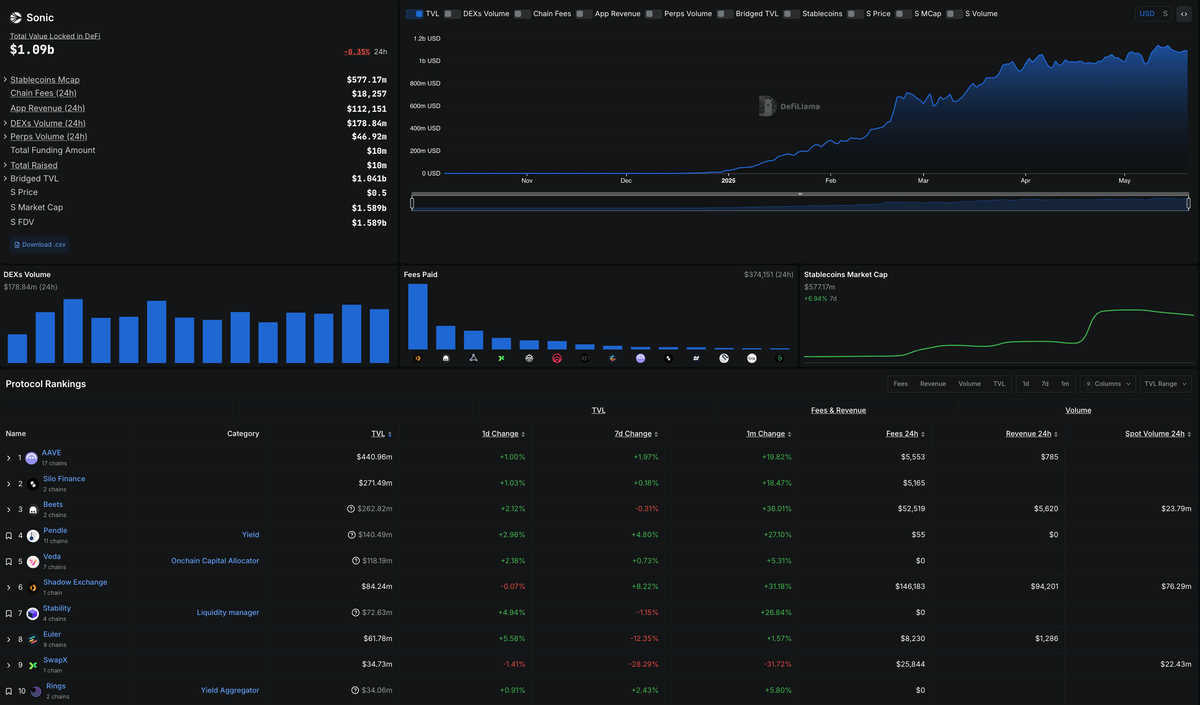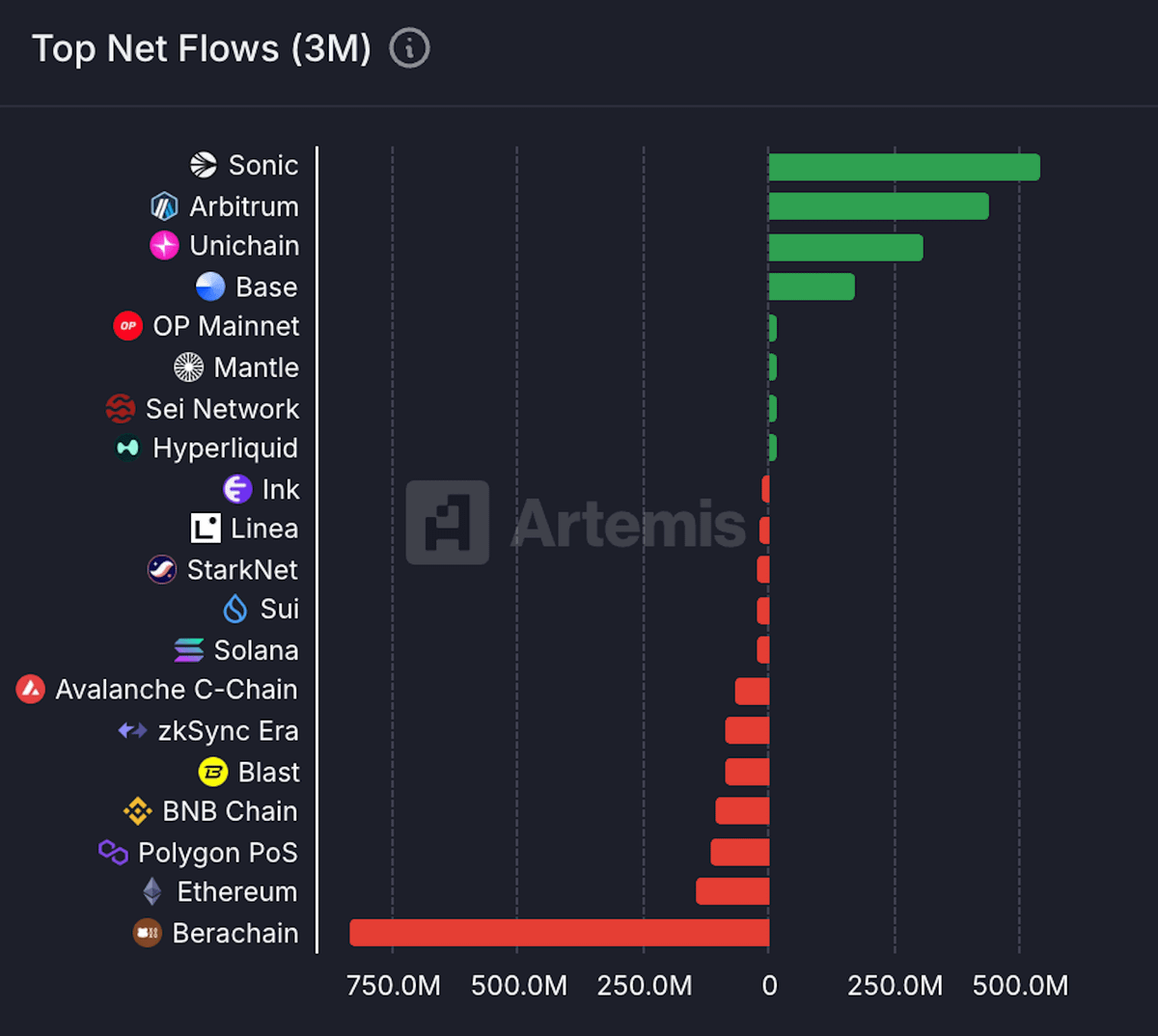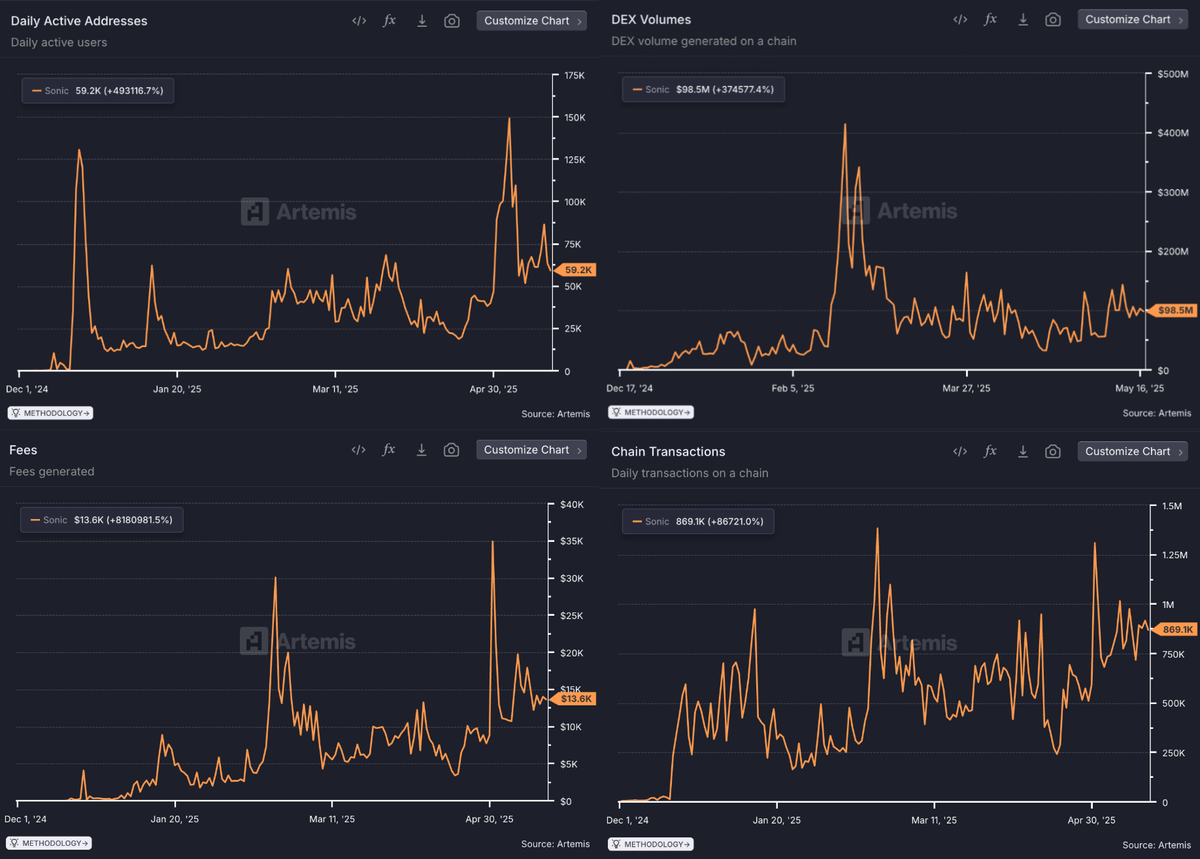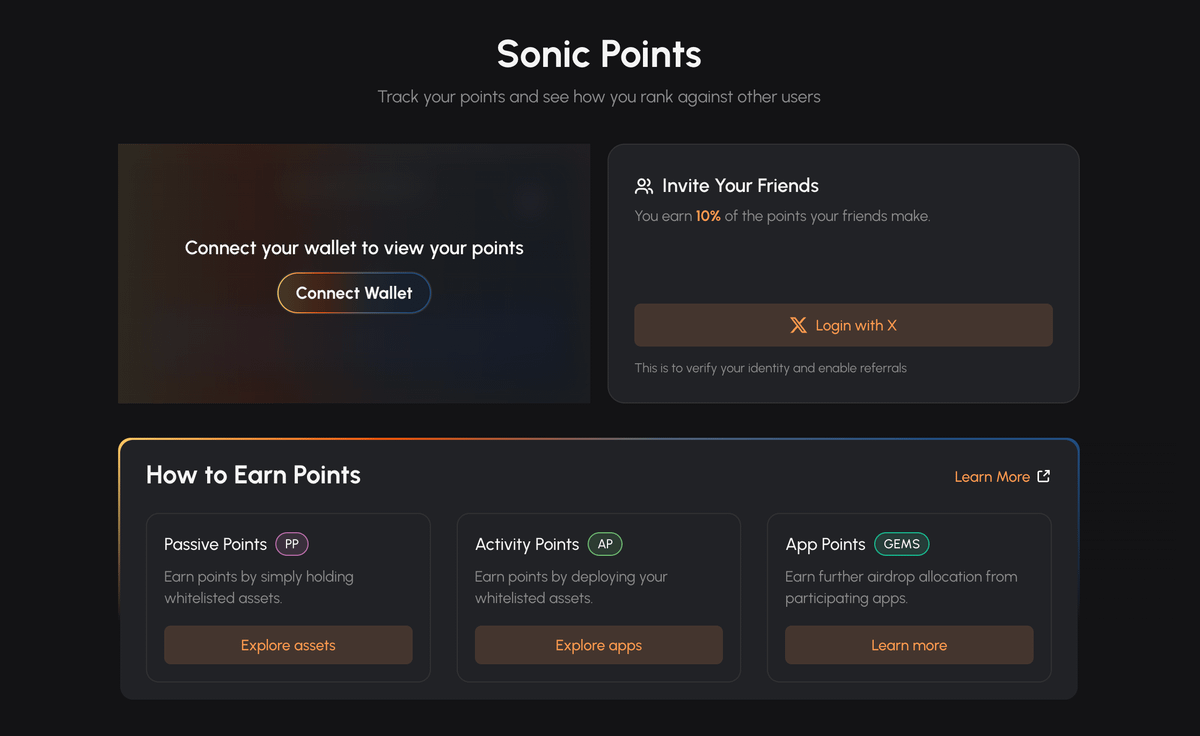Sonic đã trở thành một trong những lần ra mắt mainnet / nỗ lực GTM thành công nhất cho đến nay trong chu kỳ này.
Chỉ vài tháng sau khi ra mắt mainnet, Sonic đã vượt mốc $1 tỷ TVL và trở thành mạng lưới có dòng tiền ròng cao nhất từ đầu năm đến nay.
→ EVM hiệu suất cao, thực thi song song sắp ra mắt
→ Độ hoàn tất 320ms và giới hạn lý thuyết 370k TPS
→ Hệ thống chấm điểm tín dụng tích hợp gốc
→ Kiếm tiền từ gas (lên đến 90% dành cho nhà phát triển)
→ Chương trình khuyến khích Sonic Boom và Airdrop
→ Cổng kết nối an toàn cao đến Ethereum
→ Và nhiều hơn nữa
Với @RedactedRes, chúng tôi gần đây đã xem xét lại hệ sinh thái @SonicLabs để tìm hiểu những gì đang diễn ra onchain và lý do tại sao.
Hãy xem bài phân tích sâu của chúng tôi dưới đây! ↓
𝙏𝙧𝙖̣𝙣𝙜 𝙩𝙝𝙖́𝙞 𝙘𝙪̉𝙖 𝙈𝙖̣𝙣𝙜 𝙎𝙤𝙣𝙞𝙘
@SonicLabs đã hoạt động trên mainnet được năm tháng, vượt qua Fantom và đang hướng tới ngôi vương DeFi.
Khi Sonic vừa vượt qua mốc $1 tỷ TVL, quỹ đạo phát triển có vẻ đầy hứa hẹn.
Nhưng liệu chuỗi mới của @AndreCronjeTech có thực sự đáp ứng được kỳ vọng?
Đã đến lúc tìm hiểu ↓
Để bắt đầu, hãy phân tích sơ bộ về công nghệ của Sonic.
Chúng tôi sẽ không đi quá sâu vào chi tiết, nhưng để có cái nhìn chi tiết hơn về kiến trúc mạng và các tính năng, hãy xem bài đăng được trích dẫn bên dưới.
➀ 𝗖𝗼̂𝗻𝗴 𝗻𝗴𝗵𝗲̣̂ 𝗰𝘂̉𝗮 𝗦𝗼𝗻𝗶𝗰:
→ Thời gian hoàn tất giao dịch khoảng 700ms, vượt trội hơn các chuỗi hiệu suất cao như Aptos (900ms) và vượt xa hầu hết các chuỗi EVM.
→ Đạt thông lượng >10,000 TPS, có khả năng mở rộng lên hơn 20,000 TPS với sự phát triển liên tục để cải thiện hiệu suất thông qua thực thi song song.
→ Áp dụng cơ chế đồng thuận DAG dựa trên Byzantine Fault Tolerance không đồng bộ (aBFT) (Lachesis) kết hợp với SonicDB, tối ưu hóa yêu cầu lưu trữ của node (~giảm 90% so với Fantom Opera).
→ Sử dụng cơ chế cắt giảm dữ liệu trực tiếp để giảm nhu cầu lưu trữ của validator, cho phép hoạt động liên tục bằng cách tự động loại bỏ dữ liệu lịch sử thông qua cơ sở dữ liệu hiện tại và lưu trữ riêng biệt.
→ Phí giao dịch tối thiểu (thường <1 cent) mang lại trải nghiệm người dùng tuyệt vời.
Tuy nhiên, mặc dù đây là nền tảng mạnh mẽ, hiệu suất không phải là yếu tố duy nhất thúc đẩy sự phát triển của nền kinh tế onchain mà Sonic đang hướng tới.
Điều thực sự làm Sonic khác biệt so với các chuỗi (EVM) khác là một loạt các tính năng thực sự độc đáo, nhằm thu hút cả nhà phát triển và người dùng một cách hiệu quả.
➁ 𝗖𝗮́𝗰 𝗬𝗲̂́𝘂 𝗧𝗼̂́ 𝗞𝗵𝗮́𝗰 𝗕𝗶𝗲̣̂𝘁 𝗖𝗼̂́𝘁 𝗟𝗼̃𝗶:
→ Kiếm tiền từ phí gas: Các nhà phát triển kiếm được tới 90% phí gas được tạo ra bởi dApps của họ, trực tiếp khuyến khích phát triển chất lượng cao.
→ Chấm điểm tín dụng onchain: Chấm điểm tín dụng onchain bảo mật quyền riêng tư mà không cần KYC mở ra thị trường cho vay dưới thế chấp ước tính trị giá $11.3 nghìn tỷ.
→ Trừu tượng hóa tài khoản gốc: Tích hợp dễ dàng và tương tác người dùng thông qua đăng nhập xã hội và tài trợ phí gas từ bên thứ ba.
→ Bảo mật cầu nối mạnh mẽ: Sonic Gateway sử dụng xác thực phi tập trung và bao gồm các cơ chế rút tiền khẩn cấp tích hợp, giảm thiểu đáng kể rủi ro cầu nối truyền thống.
Được rồi, nhưng còn dữ liệu thì sao?
Liệu mọi người có thực sự sử dụng Sonic không?
Hãy xem xét kỹ hơn các chỉ số hệ sinh thái chính.
➂ 𝗣𝗵𝗮̂𝗻 𝗧𝗶́𝗰𝗵 𝗗𝘂̛̣𝗮 𝗧𝗿𝗲̂𝗻 𝗗𝘂̛̃ 𝗟𝗶𝗲̣̂𝘂
→ TVL của Sonic đã tăng nhanh từ ~$27M khi ra mắt lên khoảng $1.09B trong vòng năm tháng, cho thấy dòng vốn ổn định.
→ Mạng Sonic đã đạt được dòng vốn ròng cao nhất (~$505M trong 3 tháng qua, chủ yếu từ Ethereum) trong tất cả các chuỗi, vượt qua các đối thủ lớn như @arbitrum, @base hoặc @unichain.
→ Các giao thức DeFi hàng đầu theo TVL bao gồm @aave V3 ($440.96M), @SiloFinance ($271.49M), và @beets_fi (~$262.82M). Sự phân bổ TVL trên các ứng dụng đa dạng này giảm thiểu rủi ro hệ thống và cho thấy sự đa dạng hóa giao thức lành mạnh.
→ Số lượng địa chỉ hoạt động hàng ngày đã tăng lên mức cao nhất ~170,000, ổn định quanh ~60,000 người dùng, cho thấy khả năng giữ chân người dùng mạnh mẽ (mặc dù chỉ số này có thể dễ dàng bị thao túng).
→ Khối lượng giao dịch hàng ngày liên tục vượt quá 800,000, đạt đỉnh trên 1.3 triệu, cho thấy sự tham gia đáng kể vượt qua sự cường điệu ban đầu khi ra mắt. Tuy nhiên, cần lưu ý rằng các chỉ số này cũng dễ bị thao túng.
→ Khối lượng DEX ban đầu tăng vọt lên ~$450M hàng ngày, với khối lượng ổn định quanh ~$100M, chứng minh hoạt động giao dịch mạnh mẽ và ổn định + thanh khoản. Tuy nhiên, khối lượng hữu cơ có thể thấp hơn.
→ Phí giao dịch tạo ra đã đạt đỉnh khoảng $35,000 hàng ngày, ổn định quanh $13,600, nhấn mạnh hoạt động kinh tế đáng kể và tiềm năng doanh thu cho nhà phát triển.
→ Vốn hóa thị trường stablecoin ($577.17M) đang tăng nhanh và củng cố độ sâu thanh khoản đáng kể của mạng, hỗ trợ các hoạt động giao dịch và cho vay.
Nhìn chung, dữ liệu rõ ràng cho thấy các nền tảng mạnh mẽ, chỉ ra rằng chiến lược của Sonic để trở lại thời kỳ hoàng kim DeFi của Fantom đang hoạt động tốt.
Tuy nhiên, điều này đặt ra câu hỏi: Chính xác thì tất cả những người dùng này đang làm gì với tiền của họ trên @SonicLabs?
➃ 𝗙𝗮𝗿𝗺 𝗟𝗮̃𝗶 𝗦𝘂𝗮̂́𝘁 + 𝗛𝗲̣̂ 𝗧𝗵𝗼̂́𝗻𝗴 𝗗𝗶𝗲̂̉𝗺 𝗧𝗿𝗲̂𝗻 𝗦𝗼𝗻𝗶𝗰
Không nghi ngờ gì, một yếu tố thu hút mạnh mẽ thanh khoản và người dùng từ các chuỗi và hệ sinh thái khác là lợi suất được farm trên các pool thanh khoản và cho vay trong hệ sinh thái Sonic.
Nhiều địa điểm cung cấp thị trường stablecoin với lợi suất APY hấp dẫn từ 5-12%, trong khi các pool thanh khoản trên toàn hệ sinh thái cung cấp APR ổn định từ 15-30%, với một số pool mang lại lợi suất cao hơn, đảm bảo các ưu đãi bền vững cho các nhà cung cấp thanh khoản.
Các sản phẩm tài chính tiên tiến như @pendle_fi (token hóa lợi suất), @eggsonsonic (farm lợi suất có đòn bẩy), và @Rings_Protocol (stablecoin mang lại lợi suất) cung cấp thêm các chiến lược farm phức tạp hơn, và mở rộng phạm vi cơ hội tổng thể cho người dùng.
Cuối cùng nhưng không kém phần quan trọng, lợi suất staking vẫn tương đối hấp dẫn ở mức 5-8%, được tăng cường bởi các dẫn xuất staking thanh khoản như $stS, giúp tích hợp DeFi tốt hơn, một cải tiến lớn so với cơ sở hạ tầng staking của Fantom Opera vốn thiếu các tùy chọn staking thanh khoản.
Tuy nhiên, có lẽ không chỉ APY thu hút người dùng và thúc đẩy số lượng giao dịch hàng ngày liên tục vượt quá 1 triệu, và tổng số địa chỉ duy nhất đang tiến gần đến 2.5 triệu.
Trong khi hoạt động của nhà phát triển được thúc đẩy đáng kể bởi Quỹ Đổi mới Sonic (200M $S token được phân bổ) và các ưu đãi phát triển Sonic Boom, Sonic cũng áp dụng hệ thống điểm khuyến khích chiến lược nhằm thúc đẩy sự chấp nhận và tham gia của người dùng trên toàn hệ sinh thái.
Hệ thống điểm Sonic hoạt động bằng cách thưởng cho người dùng khi thực hiện các hành động onchain khác nhau như giao dịch, cho vay, cung cấp thanh khoản, staking và chuyển tài sản vào mạng. Mỗi hành động sẽ cấp cho người dùng một số điểm nhất định, tích lũy để xác định khả năng nhận airdrop $S token.
Để khuyến khích các hành vi cụ thể phù hợp với sự phát triển của hệ sinh thái, Sonic đã giới thiệu các hệ số nhân cho một số hoạt động, chẳng hạn như gửi stablecoin vào các thị trường cho vay chính hoặc cung cấp thanh khoản cho các cặp giao dịch cốt lõi, cấp hệ số nhân điểm lên đến 12-15x. Điều này làm tăng đáng kể giá trị cảm nhận của việc tham gia vào các hành động quan trọng này, tạo ra động lực mạnh mẽ để người dùng tích cực và liên tục tương tác với các ứng dụng DeFi trên Sonic.
Do đó, người dùng không chỉ bị thu hút bởi lợi suất ngay lập tức mà còn bởi tiềm năng tăng giá đáng kể liên quan đến các đợt airdrop trong tương lai. Cấu trúc phần thưởng gamified này đã góp phần đáng kể vào việc giữ chân người dùng sau khi ra mắt (ít nhất là cho đến nay), điều này được phản ánh trong số lượng địa chỉ hoạt động hàng ngày cao và khối lượng giao dịch ổn định của hệ sinh thái.
Hệ thống airdrop dựa trên điểm của Sonic dường như đã hiệu quả trong việc xúc tác sự chấp nhận hữu cơ và tăng trưởng cộng đồng, đảm bảo người dùng vẫn hoạt động vượt qua các ưu đãi farm ngắn hạn của các giao thức lớp ứng dụng.
➄ 𝗞𝗲̂́𝘁 𝗟𝘂𝗮̣̂𝗻
Các chỉ số ban đầu của Sonic cho thấy sự thu hút đáng kể, được hỗ trợ bởi khả năng kỹ thuật mạnh mẽ và các ưu đãi được thiết kế chiến lược. Tuy nhiên, một phần đáng kể của sự tăng trưởng nhanh chóng dường như liên quan chặt chẽ đến các cấu trúc phần thưởng tích cực hiện tại.
Trong tương lai, thách thức chính nằm ở việc chuyển đổi sự chấp nhận được khuyến khích này thành hoạt động hữu cơ bền vững và các dApps sáng tạo. Mặc dù các đổi mới của Sonic rất đáng khen ngợi, khả năng tồn tại lâu dài và khả năng phục hồi thực sự của mạng sẽ phụ thuộc nhiều vào việc giữ chân người dùng và hoạt động hệ sinh thái sau khi các chương trình ưu đãi giảm dần.
Sẽ rất thú vị để quan sát liệu Sonic có thể duy trì động lực ban đầu và chuyển đổi sự quan tâm tạm thời thành sự tham gia cơ bản lâu dài hay không. Các nguyên mẫu DeFi độc đáo và các tính năng tích hợp như chấm điểm tín dụng onchain, kiếm tiền từ phí gas và trừu tượng hóa tài khoản gốc có thể đóng vai trò quan trọng ở đây.
⚠️ Đây không phải là lời khuyên tài chính và báo cáo KHÔNG được tài trợ bởi bất kỳ bên thứ ba nào.




42,27 N
14
Nội dung trên trang này được cung cấp bởi các bên thứ ba. Trừ khi có quy định khác, OKX không phải là tác giả của bài viết được trích dẫn và không tuyên bố bất kỳ bản quyền nào trong các tài liệu. Nội dung được cung cấp chỉ nhằm mục đích thông tin và không thể hiện quan điểm của OKX. Nội dung này không nhằm chứng thực dưới bất kỳ hình thức nào và không được coi là lời khuyên đầu tư hoặc lời chào mời mua bán tài sản kỹ thuật số. Việc sử dụng AI nhằm cung cấp nội dung tóm tắt hoặc thông tin khác, nội dung do AI tạo ra có thể không chính xác hoặc không nhất quán. Vui lòng đọc bài viết trong liên kết để biết thêm chi tiết và thông tin. OKX không chịu trách nhiệm về nội dung được lưu trữ trên trang web của bên thứ ba. Việc nắm giữ tài sản kỹ thuật số, bao gồm stablecoin và NFT, có độ rủi ro cao và có thể biến động rất lớn. Bạn phải cân nhắc kỹ lưỡng xem việc giao dịch hoặc nắm giữ tài sản kỹ thuật số có phù hợp hay không dựa trên tình hình tài chính của bạn.


